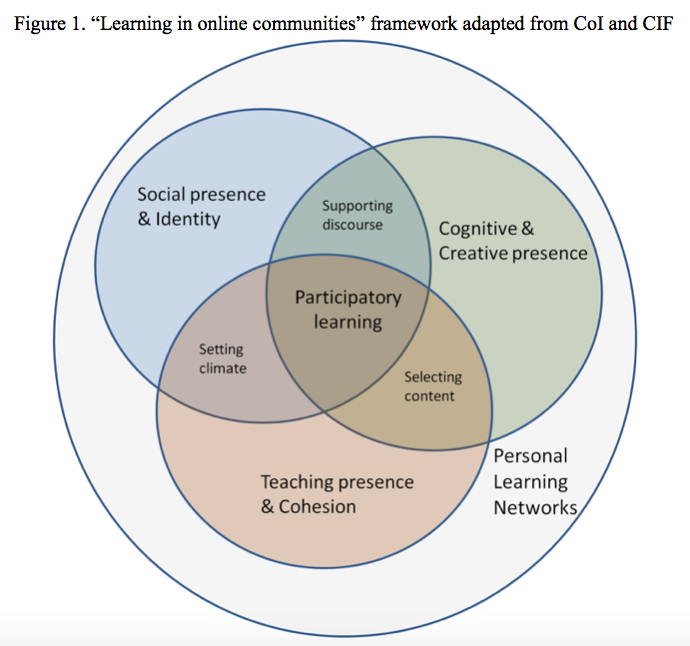
Technological developments make learning online convenient, accessible and in many cases, free. Yet, there are stories of high dropout rates and the fear of loneliness confirms distance is both geographical and psychological. So can online programmes be effectively designed to allow learners to feel part of a community and thus go the distance of the course? This question is tackled head on by the tag-team of my Masters course director and Masters dissertation tutor in their paper Cultivating a community of learners in a distance learning postgraduate course for language professionals.
On first glance, this paper looks strikingly familiar. Surely I am on a distance learning postgraduate course for language professionals? And so the penny drops. Myself, and my classmates, have been archetypal guinea pigs in a university laboratory. Our Masters programme Digital Technologies for Language Teaching IS their paper. We are living through their proposed theoretical framework. The outcomes of the experiment are what we produce on the course. What a clever game to play. I love it.
The abstract mentions the Masters programme as a “highly participatory pedagogical model of online learning which combines the Community of Inquiry model (Garrison et al., 1999) with the Community Indicator Framework (Galley et al., 2012)’. The word ‘participatory’ immediately reminds me of my mum’s first experience of online learning:
“I was apprehensive. What I learnt was, if you fully engage in it, engage in the Facebook groups and actually put yourself out there and speak to people: you get back what you put in.”
There you go. The more you put in, the more you get out. Period. Participation is the over-arching obstacle. Thus, according to the paper, the main challenges of online distance learning are:
- possession of digital skills
- balance of work responsibilities
- feeling of disconnection and isolation
But overcoming these challenges:
- affects the quality of the learning experience
- enhances academic achievements
- increases student retention
So the design of the learning experience is paramount to its success. The authors recognise this and reconcile two theoretical models of online community to develop a framework for monitoring and supporting the development of the community:

It is proposed that three key areas combine to make a highly participatory learning experience (see above). And the one that stands out to me is Cognitive & Creative presence. Perhaps it’s because I love the idea of sharing what you learn and achieve. I do this by writing this blog, making videos, recording interviews. In a way, this is what I hope to pass on to my students, the ability to construct meaning through communication and the creative capability to make shared artefacts and knowledge (Goria & Konstantinidis, 2016).
That is not to say Social presence & Identity is any less important in online communities. By projecting your identity into the group you carve out an individual space, for example, if everyone takes up a role, say, note-taker, summariser, discussion leader, etc., this helps to develop a sense of responsibility and belonging. At the same time, acknowledging shared traits among community members, helps you feel part of the group. In sum, a successful community is one that makes you comfortable enough to express yourself and how you feel.
Teaching presence & Cohesion comes about through design, where activities facilitate bonding between students and teachers, and amongst students themselves. This is what I am attempting to do in another project – designing online group activities, the focus being on ‘group learn’. Therefore, as I consider changing the topic area of my final dissertation project, I think perhaps delving deeper into this area would not only help me understand how effective the strategies implemented in my course were for building online community, but there would also be an opportunity for immediate practical application.
Final Thoughts
Overall, I am excited by this new framework. It is directly related to my online learning experience, would have me analyse the cultivation of online community and may lead to immediate application in the real-world. That said, the discussion about PLN‘s in this article piqued my interest, too. Having created a visualisation of my own PLE two years ago, I’d like to reflect on the growth and development of my own learning environment in my next post.
Image:
Bag and Hands by Alejandro Escamilla, Unsplash.com
Reference
Goria, C. & Konstantinidis, A (2016) Cultivating a community of learners in a distance learning postgraduate course for language professionals, EUROCALL 2016 – CALL Communities and Culture
